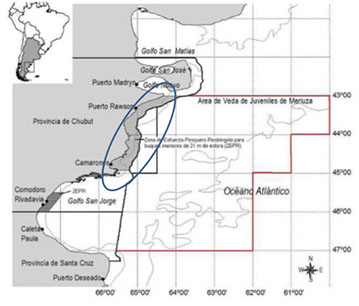
Sustainability
Government
The National Institute for Fishery Research and Development (Instituto Nacional de Investigación y Desarrollo Pesquero, INIDEP) began studies on Argentine red shrimp at a national level in the 1980's. The Federal Fisheries Regime, established by National Law 24922, together with its amendments and regulatory decree constitute the legal basis on which the National Fisheries Policy is developed. Such law provides relevant aspects of sea fishing, conservation and management of living marine resources and a fisheries regime including infringements and penalties.
In accordance with the provisions of the aforementioned law, the Federal Fishery Council is composed by:
- A representative of every seaboard province (Buenos Aires, Río Negro, Chubut. Santa Cruz and Tierra del Fuego)
- A fisheries secretary
- A representative of the Secretary of Natural Resources and Sustainable Development
- A representative of the Ministry of International Affair, International Trade and Worship.
- Two representatives appointed by the National Executive Power.
The Federal Fishery Council created guidelines for establishing catch limits, a system for monitoring fishing activity, monitoring the fishery health and enforcement of fishery laws. Since placing these steps in place the Argentine red shrimp population has grown robustly and has reached record numbers.
Fishery Improvement Project

Currently the Argentine red shrimp shore fishery is undergoing a Fisher Improvement Project (FIP).
Under Review in This FIP
- To evaluate the bycatch species of the Argentine red shrimp coastal fishery
- To evaluate any potential impact of the Argentine red shrimp fishery on the seabed and surrounding ecosystem
- To coordinate the different jurisdictions that manage the Argentine red shrimp fishery
- To assure a formal and regular assessment of the efficacy of the fishery's management
History
Under Argentine Law Nº 24.922 provincial governments have jurisdiction over the harvest of living resources in their coastal water from the shoreline to up to twelve nautical miles out. The Argentine red shrimp fishery is one of the most important in the Southwest Atlantic. The coastal fisheries are measured from baselines that define the characteristics of the fisheries.
This fishery under FIP consists of vessels less than 21 meters in length which use bottom trawl nets. The area under review is the waters off the providence of Chubut primarily in the Restricted Fishing Effort Zone between Punta León and Cabo Dos Bahías. Rawson port is the landing site for this day boat fishery from October through March.
The National Institute for Fishery Research and Development (Instituto Nacional de Investigación y Desarrollo Pesquero, INIDEP) began studies on Argentine red shrimp at a national level in the 1980's. These studies revealed three distinct reproduction zones south of Rawson, north of San Jorge Gulf and south of San Jorge Gulf. There is slight variation in the start of breeding time, lengths of breeding time and intensities of breeding but the variations were not found to be great enough to consider these groups separate sub stocks. For this reason they are all viewed as a single stock fishery creating a need to coordinate regulations between Chubut and Santa Cruz and the at sea fishery in national waters.
In the waters off Chubut mobile closures are used to regulate the fishery in response to real time stock status. These closures are also coordinated with the actions taken at the national levels with information collected by INIDEP and by Chubut's onboard observers program.
Between 2009-2013 the Argentine red shrimp fishery averaged total annual landings around eighty thousand metric tons. In 2013 total landings reach one hundred metric tons. Of the total fishery landings the coastal fleet of Chubut captured approximately twenty percent of the total landings.
Argentine hake is the only significant bycatch of the Chubut fishery. The total landings consist of 96.6% of Argentine red shrimp and 3.4% of Argentine hake.
Goals
- To conduct and Ecological Risk Assessment for the Effects of Fishing to serve as input to the management system and to an Marine Stewardship Council (MSC) full assessment.
- To promote the development of a minimum coordination protocol for fishery research and management among the different jurisdictions involved in the fishery’s administration.
- To raise awareness among and involve crew members in research activities related to the FIP.
- To promote the regular assessment of the efficacy of the fishery’s management system.
- To obtain MSC certification for the unit of assessment addressed by this FIP.